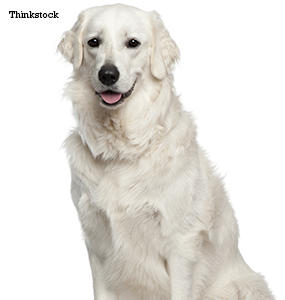Background
The Kuvasz originates from Tibet, but was developed in Hungary as a flock-guarding breed. The name Kuvasz comes from the Turkish word “kawasz,” which means armed guard of the nobility. The Kuvaszs were companion dogs for the rulers of the Hungarian and other European empires. The dogs earned a reputation for protecting families from harm and were owned exclusively by royalty at first. Several centuries later the breed started to find ownership among the commoners; they were used on farms and worked with sheep and cattle.
The Kuvasz was recognized by the American Kennel Club in 1931.
Sizing up
- Weight: 70 to 115 lbs.
- Height: 26 to 30 inches
- Coat: Dense, double coat that ranges in texture from wavy to straight
- Color: White
- Life expectancy: 12 to 14 years
What’s the Kuvasz like?
The Kuvasz is devoted to his family. He isn’t overly affectionate but he loves his people! He shows his affection by protecting -- especially younger children; however, be wary when you have strange children over because he may try to intervene during playtime and defend “his” child.
The Kuvasz is an active dog and requires plenty of exercise. He was bred to work all day on rough terrain so he loves a good hike or a nice long walk.
The Kuvasz tends to mature more slowly than other breeds. Be patient and understand you’ll want to begin training as soon as possible. He needs a strong leader because he can be very independent and headstrong at times. Be firm and consistent but definitely praise him with rewards when he does something correctly.
The Kuvasz does not require any special grooming; use a pin brush with rounded pins or a comb to remove any knots.
Health
The Kuvasz is generally a healthy dog but watch for any of the following conditions:
- Hip dysplasia
- Osteochondrosis
- Progressive retinal atrophy
- Hypothyroidism
- Von Willebrand’s disease
Takeaway Points
- The Kuvasz is an excellent guard dog.
- The Kuvasz needs to begin a training regimen as soon as he can.
- The Kuvasz would make a great companion for someone who loves to jog, hike, or bike.
- The Kuvasz takes very little time to groom.
If you have any questions or concerns, you should always visit or call your veterinarian -- they are your best resource to ensure the health and well-being of your pets.
